727系、円相、抽象
727, Ensō (circle) and Abstraction

「円相」シリーズ 2015年
展示風景:「村上隆の五百羅漢図展」 森美術館、東京、2015年 撮影:高山幸三
"Ensō" series 2015
Installation view: "Takashi Murakami: The 500 Arhats," Mori Art Museum, Tokyo, 2015 Photo: Takayama Kozo
©2015 Takashi Murakami/Kaikai Kiki Co., Ltd. All Rights Reserved.
村上隆は活動初期より、アニメ・マンガのキャラクターを日本絵画の伝統の流れで捉えようと試みています。本展で展示されている約30メートルにおよぶ新作絵画《宇宙の深層部の森に蠢く命の図》は、自身が創作したキャラクターDOB君が平安時代の絵巻物《信貴山縁起(しぎさんえんぎ)》を想起させる雲に乗る初期の代表作《727》の最新版です。作家がこの20年間描いてきたキャラクターの数々や代表的な主題がひとつの流れとして合体した本作は、作家の「名作集」あるいは、「ベストアルバム」にたとえることが出来るでしょう。人々はタイトルに作品の意味を見出そうとしますが、実はこの作品には両者の関連性はありません。村上は、鑑賞者がタイトルから別の想像をしてしまい作品を前に困惑する、つまり「作品理解への入り口に立たされ途方に暮れること」を望んでいます。彼にとっては、「現実から圧倒的に距離を取って鑑賞する事」が、芸術の重要な部分であると言います。
サイケデリックな作風の抽象画では、80年代のニューペインティングや水木しげるによるマンガの妖怪の形象を軸に、スターウォーズ的ハリウッドの特殊効果や日米の戦後前衛絵画、書道等の融合が見られます。
また、悟りや真理、仏性だけでなく宇宙全体を象徴的に表す円相画は、完成した絵に「HOLLOW(空洞・虚)」という文字をスプレーでグラフィティのように表現することから生まれました。その最新連作《円相》では、村上の自画像が右から左へ移行しながら徐々に消滅しています。絵画に対する先入観や自意識の否定から根源的な自由を導く術(すべ)を、グラフィティアートや禅画の円相図に重ね合わせているようです。こうして、村上は、超越や悟りに関する伝統的な主題に立ち返ったり、古典や自身の画業を再訪・変容させながら、過去に新たな息を吹き込み、「絵画の延命を謀っているのだ」とうそぶくのです。
From the very beginning of his career, Takashi Murakami has attempted to capture anime and manga characters as an extension of the Nihonga tradition. The 30-meter-long painting A Picture of Lives Wriggling in the Forest at the Deep End of the Universe displayed at the exhibition is his latest variation on 727, an important early work featuring Murakami's original character Mr. DOB riding on a cloud in a manner reminiscent of the Heian period picture scroll Shigisan Engi (Legend of Mt. Shigi). This latest painting, in which the various characters and subjects Murakami has portrayed over the past 20 years are combined in a single plane, could be likened to a "greatest hits" album in which the artist's masterpieces are collected in one place. Traditionally, viewers may try to discern the meaning of a work in its title, but here, in fact, there is no connection between the two. Murakami aims to have viewers imagine the work by reading the title and then find themselves perplexed by the actual painting, or as Murakami himself puts it, "to be stood at the threshold of understanding the work only to then find themselves at a loss." According to Murakami, "to keep an overwhelming distance from reality when viewing work" is an important part of art.
In Murakami's almost psychedelic abstract paintings, one can see a blending of Star Wars-like Hollywood special effects, Japanese and U.S. post-war avant-garde painting, and calligraphy, manifesting around forms from 1980s New Painting and the phantoms from the manga of Mizuki Shigeru.
His ensō paintings, which symbolically represent not only enlightenment, truth and the Buddha-nature, but also the universe in its entirety, originated from Murakami spraying the word "HOLLOW" on a completed painting in a graffiti-like fashion. In his latest addition to this series, Ensō, a Murakami self-portrait gradually fades as the image transitions from right to left. Here, it would seem that Murakami locates in graffiti art and Zen Buddhist ensō paintings a resonance with the artist's attempts to find fundamental freedom through the denial of self and preconception about paintings. By returning in this way to traditional subjects such as transcendence and enlightenment and revisiting classical paintings as well as his own work Murakami is breathing new life into the past and professes to be "extending the life of painting."
達磨
Daruma
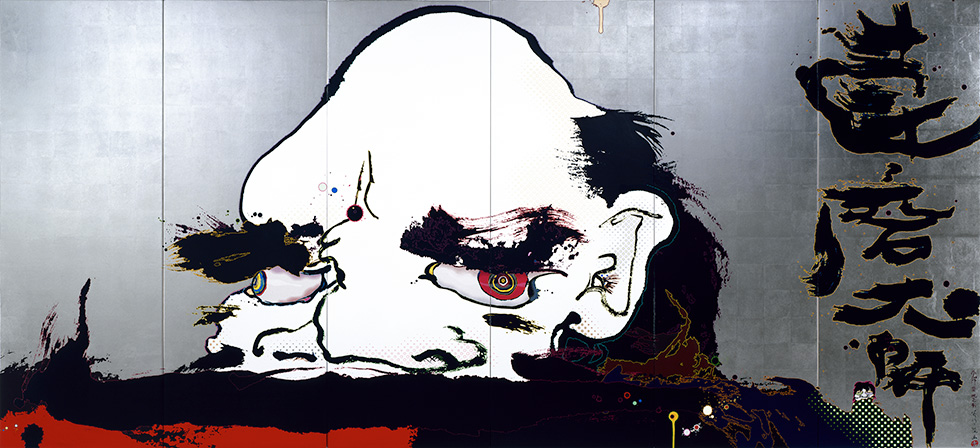
《達磨大師》2007年
アクリル、プラチナ箔、カンバス、板にマウント 1601×3510×50mm(六曲) 個人蔵
Courtesy Blum & Poe, Los Angeles
Daruma the Great 2007
Acrylic and platinum leaf on canvas mounted on board 1601 x 3510 x 50mm (6 panels) Private Collection
Courtesy Blum & Poe, Los Angeles
©2007 Takashi Murakami/Kaikai Kiki Co., Ltd. All Rights Reserved.
村上隆は達磨絵を2007年に初めて発表しましたが、これは日本美術の伝統に改めて取り組むという作家の新たな方向性を告げるものとなりました。
会場にて隣に並ぶ作品は、雪舟の水墨画でも有名な、達磨に弟子入りを拒まれた慧可(えか)が自らの腕を切り落としその決意のほどを示したという逸話を描いたものです。村上は慧可の腕に焦点を絞り、逸話的な部分よりも、絵画的な構成を重視しています。
また、村上が「達磨」と呼ぶ、展示室の中央に鎮座する彫刻作品《宇宙の産声》は、2005年六本木ヒルズの毛利庭園に展示された《とんがりくん(二重螺旋逆転)》やロサンゼルス現代美術館で公開の《大仏オーヴァル》に続く、革新的な彫刻を追求する最新形です。発展を追求しつづける近現代の社会構造が自らの重みで潰れていく、という現実を表現したという本作は、モンスターのようでもあり、また金色に輝く体は荘厳さも湛えています。354個の目、105本の髭、1200本以上もの歯を持った巨体が身もだえするような姿は、彫刻における「瓦解する形状」の系譜を意識しています。崩れ行くこの世をテーマに、作家の揺らぐ心情をそのまま表し、10年以上の歳月をかけてもまだ完成に至らない、という終わりのない大作彫刻です。
Takashi Murakami unveiled his first Daruma (Bodhidharma) paintings in 2007, signaling a new direction in which he would tackle afresh the traditions of Japanese art.
The adjacent work in the exhibiton shows the anecdote, also famously depicted in the ink and wash painting by Sesshu Tōyō, about Taiso Eka (Dazu Huike) cutting off his own arm to prove his resolve to Bodhidharma, who had initially refused to teach him. Murakami focuses on Eka's arm, emphasizing the pictorial composition rather than the anecdotal content.
Located in the center of the gallery is The Birth Cry of a Universe, a sculptural work which Murakami also refers to as a "Daruma" work. It is his latest venture in innovative sculpture, following on Mister Pointy, which was installed in the Mohri Garden at Roppongi Hills in 2005, and Oval Buddha, unveiled at the Museum of Contemporary Art, Los Angeles. Representing the reality of our contemporary social structure—with its constant pursuit of development—collapsing under its own weight, it resembles on one hand a monster, while on the other its body, sparkling with gold, is infused with majesty. In arriving at this figure, a giant writhing body with 354 eyes, 105 whiskers and over 1200 teeth, Murakami was conscious of the lineage of "formal deterioration" in sculpture. Thematically linked to our deteriorating world and expressing the unsettled state of the artist's mind, this endless, massive sculpture is still incomplete after having been worked on for over ten years.
DOB君
Mr. DOB
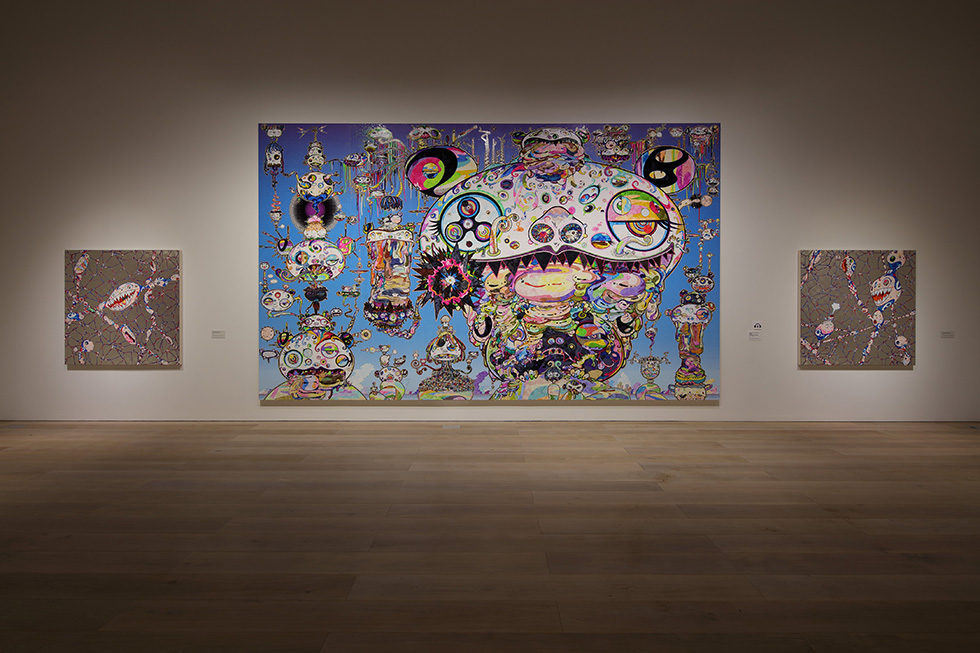
展示風景:「村上隆の五百羅漢図展」 森美術館、東京、2015年 撮影:高山幸三
Installation view: "Takashi Murakami: The 500 Arhats," Mori Art Museum, Tokyo, 2015 Photo: Takayama Kozo
©2015 Takashi Murakami/Kaikai Kiki Co., Ltd. All Rights Reserved.
キャラクターを現代美術の主題に押し上げたとも言えるDOB君は、1993年、にわかに日本発の「キャラクター文化」が注目されるなか、その意味の脱臼を図るべく生み出されました。そのかたちは、マンガ『ど根性ガエル』のピョン吉や、ビデオゲームに登場するソニック・ザ・ヘッジホッグなどが参照されました。名前は、コメディアン・由利徹の「おしゃまんべ」とマンガ『いなかっぺ大将』の「どぼじで、どぼじて」という2つのギャグを意味なく合体させた造語のローマ字表記の最初の3文字「DOB」に由来します。
つまり、「DOB」そのものには意味がないのです。これは、村上が大学の博士論文のタイトルである『美術における「意味の無意味の意味」をめぐって』に由来する、作家独特のニヒリズム、シニシズムを経た、作品制作の動機でも、また主題そのものでもあるのです。その後、DOB君のデザインは細かく変容しながら増殖を続け、多様な文脈に接続・侵入し、さまざまな領域を横断する村上の自画像のような存在になっていきました。
DOB君がモンスター化したような「たんたん坊」は、村上が子どものころ好きだった水木しげる作のマンガのキャラクターで、口から痰を吐く巨大な頭だけの妖怪が基になっています。その複雑怪奇なイメージには、原子力開発の発展に対する村上の個人的な不安が反映されています。さらに、村上の自画像の極限の姿とも言えるのが「ゲロタン」です。ゲロを吐いてのたうちまわる「ゲロタン」は、村上が国際舞台で活躍し始めた頃、プレッシャーに押しつぶされそうになる自分の情けない心情をキャラクターに合成して生まれたものです。これら複雑な構図の絵画には、伊藤若冲を参照した「十文字構図」や、視線の動きによって空間的な広がりを生む手法などが用いられ、キャラクターの表情とも相俟って画面にストーリーを生み出すことが図られています。
Mr. DOB, a cartoon character elevated to the level of contemporary art subject, was born in 1993 with the aim of disjointing the meaning of Japanese "character culture," a subject that had suddenly become the focus of attention at the time. His form drew on elements of a character called Pyonkichi from the manga Dokonjo Gaeru (Gutsy Frog) and the video game character Sonic the Hedgehog, while his name is a contraction of the Romanized spelling of a coinage created through the meaningless combination of comedian Yuri Toru's catchphrase, "oshamanbe," and the line "dobojite dobojite" (Why? Why?) from the manga Inakappe Taishō.
In other words, the name "DOB" itself has no meaning. This thought, which dates back to the title of his doctoral thesis, "Imi no muimi no imi" (The meaning of the nonsense of the meaning), also serves as both the motivation and the very subject of Murakami's artistic practice via his unique brand of nihilism and cynicism. The design of Mr. DOB has been morphing in detail and proliferating ever since, the character becoming an alter ego or self-portrait-like presence that joins/infiltrates diverse contexts and traverses various boundaries.
Tan Tan Bo, in a sense a reincarnation of Mr. DOB as a monster, is based on a manga character created by Mizuki Shigeru, a favorite of Murakami's when he was a boy, in the form of a phantom consisting solely of a giant face spitting out phlegm from its mouth. The complex image of the phantom reflects Murakami's personal anxiety regarding the expanding development of nuclear power. At one extreme of Murakami self-portraits is Gero Tan. Gero Tan, who appears to writhe while vomiting, was born when Murakami conflated the character of Tan Tan Bo with his own wretched sense of cracking under pressure at a time when his career first expanded to the international arena. These paintings employ a complex "cruciform composition" that references the work of Itō Jakuchu and a technique that generates spatial expansiveness through the movement of the viewer's gaze. These elements, in combination with the characters' expressions, aim to create a story within the canvas.
五百羅漢図 −「青竜」「白虎」
The 500 Arhats – "Blue Dragon" and "White Tiger"
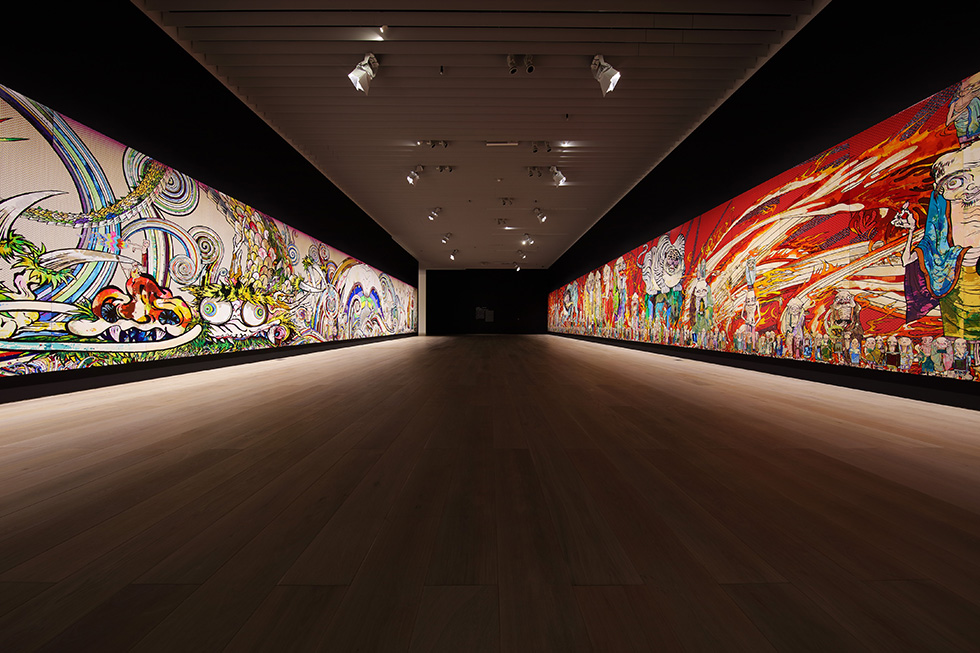
《五百羅漢図》(部分) 2012年 アクリル、カンバス、板にマウント 302x10,000cm 個人蔵
展示風景:「村上隆の五百羅漢図展」 森美術館、東京、2015年 撮影:高山幸三
The 500 Arhats (detail) 2012 Acrylic on canvas mounted on board 302x10,000cm Private collection
Installation view: "Takashi Murakami: The 500 Arhats," Mori Art Museum, Tokyo, 2015 Photo: Takayama Kozo
©2012 Takashi Murakami/Kaikai Kiki Co., Ltd. All Rights Reserved.
本作について村上隆は、「東日本大震災に際し、日本国家の有事を前にしたわれわれ国民の無力感、そんな無力感の中でも人は生きていかなければならない……。絶望からの復活には、たとえ作り話でも、希望を唱えるお話が必要だ。それらは歴史の中で、宗教であったり伝説であったりしてきたのだろう。五百羅漢は500種の人の苦しみをいやしてくれるという逸話もある。震災という死生観のぎりぎりのところが問われるような状況が出現し、五百羅漢というモチーフは俄然リアリティを帯びてきた。」と語っています。こうして描かれた作品は、高さ3メートル、幅は延べ100メートルにもおよびます。東西南北を司る四神である「青竜」「白虎」「朱雀」「玄武」の名をそれぞれ冠した4面で構成され、十六羅漢を中心に500体の羅漢と霊獣、霊鳥などが、燃え盛る炎や吹きすさぶ風を背景に、幻想的かつダイナミックに描かれています。細部に目を移せば、綿密な人物描写、幾重にもおよぶ絵具の層、ラメに覆われた表面の艶やかな仕上げなど、高度な技術で丹念に作り込まれていることが見てとれます。
Regarding this work, Takashi Murakami comments: "At the time of the Great East Japan Earthquake and Tsunami, faced with a national emergency, the Japanese people experienced a sense of helplessness, yet despite this sense of helplessness people had to continue to live their lives... In order to recover from despair, we needed a narrative that would restore our hope, even if that narrative was a fictional one. Throughout history, religion and legends have offered such narratives, and now those stories are needed again. The Five Hundred Arhats is a story about healing 500 different varieties of human suffering. The balance between life and death was called into question after great natural disasters and the motif of the Five Hundred Arhats suddenly started to seem relevant."
The resulting work here is a massive painting measuring three meters tall and 100 meters wide all together. It comprises four sections, each of which is named after one of the four Taoist gods that reign over the four points of the compass: the Blue Dragon of the east, the White Tiger of the west, the Vermilion Bird of the south, and the Black Tortoise of the north. Grounded by particular focus on the sixteen central arhats, it depicts in a dreamlike, dynamic fashion a total of 500 arhats along with various sacred animals and birds against a background of raging flames and roaring winds. Close inspection reveals the extent to which the individual elements, including the detailed portrayal of characters, the multiple layers of paint, and the lustrous finish of the glitter-covered surface, have been painstakingly incorporated into the work using sophisticated techniques.
五百羅漢図 −「玄武」「朱雀」
The 500 Arhats – "Black Tortoise" and "Vermilion Bird"
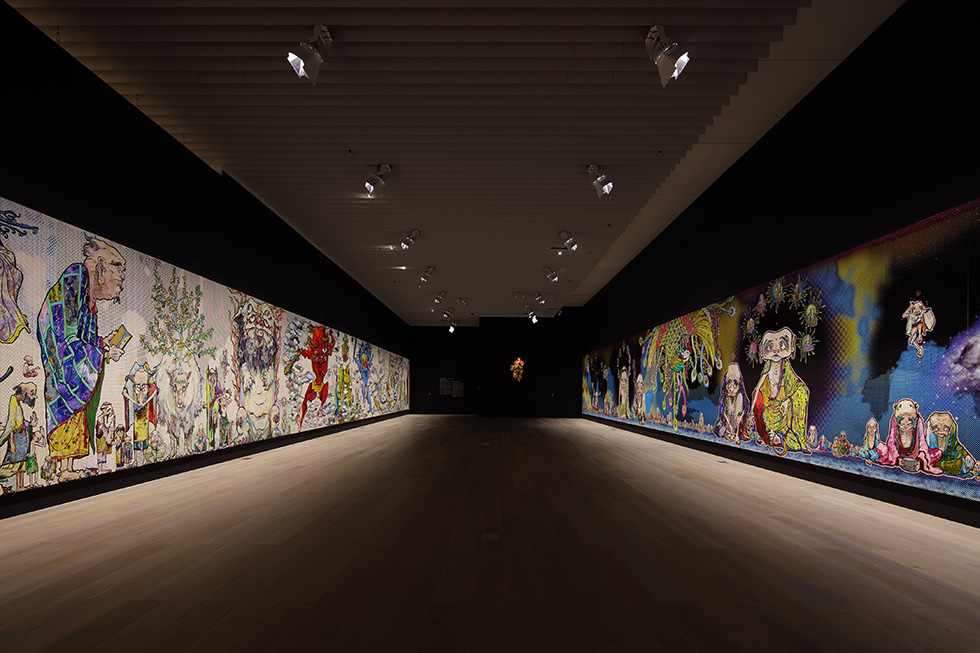
《五百羅漢図》(部分) 2012年 アクリル、カンバス、板にマウント 302x10,000cm 個人蔵
展示風景:「村上隆の五百羅漢図展」 森美術館、東京、2015年 撮影:高山幸三
The 500 Arhats (detail) 2012 Acrylic on canvas mounted on board 302x10,000cm Private collection
Installation view: "Takashi Murakami: The 500 Arhats," Mori Art Museum, Tokyo, 2015 Photo: Takayama Kozo
©2012 Takashi Murakami/Kaikai Kiki Co., Ltd. All Rights Reserved.
北方を司る玄武は、通常、亀と蛇が合体した姿で表されますが、この画中ではその姿は描かれておらず、中央の霊山とその右側の霊獣・蜃(しん)が、それぞれ亀と蛇のイメージの代わりになっています。2012年カタール・ドーハでの展示の際は、未完成で四つ目の巨大な霊獣などは描かれておらず、この完成版は今回、世界初公開となりました。南方を司る朱雀は、近世の鳳凰の図柄を元に手塚治虫の「火の鳥」のイメージが加味されています。宇宙的な背景に自在に浮遊する羅漢はまるで、巨大な波に乗って鎮魂のために私たちのもとにやって来たかのようです。過去のさまざまな羅漢図を研究し、現代ならではの五百羅漢図を目指したという本作には、東洋の伝統的な図像と、現代の雑誌やマンガなどから引用した要素が渾然一体となっています。
パブロ・ピカソがスペイン内戦の悲劇を描いた《ゲルニカ》に例え、本作を「村上のゲルニカ」と評する声があります。2011年の東日本大震災、そして原発事故に直面し、多くのアーティストたちが無力感を抱く一方で、さまざまな活動も行われました。社会の危機的状況においてアーティストや芸術に何が出来るのか――村上は、過去を現在に、現在を未来に伝えるため、若いアーティストたちとともに後世に残るような巨大絵画を作り上げました。《五百羅漢図》はまさに、村上隆の出した答えと言えるでしょう。
The creature that reigns over the north is usually portrayed as a cross between a turtle and a snake, but in Murakami's work the creature itself is not depicted. Instead, the sacred mountain in the center and the sacred animal, Shen, next to it serve as substitutes for images of a turtle and snake, respectively. When it was exhibited in Doha, Qatar in 2012, this section of the painting was incomplete, lacking among other things the fourth giant sacred animal, making this the first exhibition of the completed work anywhere in the world. The Vermilion Bird that reigns over the north incorporates images from Tezuka Osamu's Hinotori (Phoenix) based on early-modern Chinese phoenix designs. Arhats, who float freely in the space-like background, almost appear as if they have visited us riding on gigantic waves for the purposes of spirit pacification.
In this work, for which Murakami and his assistants examined various arhat imagery from the past as part of an effort to create a decidedly modern depiction of the Five Hundred Arhats, traditional Eastern iconography and elements borrowed from contemporary magazines and manga form a harmonious unit.
Some have called it "Murakami's Guernica," referencing Pablo Picasso's masterpiece Guernica, which was painted as a response to the tragedy of the Spanish Civil War. Confronted with the Great East Japan Earthquake and Tsunami and the subsequent nuclear power plant disaster, many artists were seized by a sense of helplessness, while others undertook various activities in response. When a society finds itself in a critical situation, what is it that its artists and art can do? In order to convey a message from the past to the present, and from the present to the future, Murakami has joined forces with young artists to produce the kind of massive painting that will stand the test of time. Indeed, one could say that The 500 Arhats is Takashi Murakami's answer to this question.
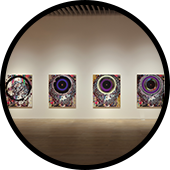
 達磨
達磨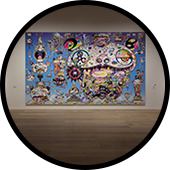 DOB君
DOB君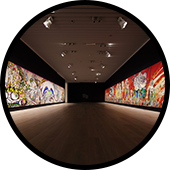 五百羅漢図 −「青竜」「白虎」
五百羅漢図 −「青竜」「白虎」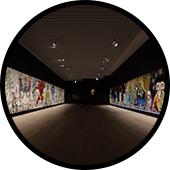 五百羅漢図 −「玄武」「朱雀」
五百羅漢図 −「玄武」「朱雀」